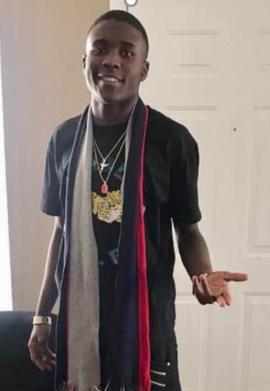
Shamar Betts before his judicial ordeal commenced
On April 8, the case of Urbana resident Shamar Betts moved to the United States Court of Appeals for the Seventh Circuit. Betts was arrested in June, 2020 in the midst of a national crackdown on protests against the murder of George Floyd by Minneapolis police officers. The nineteen-year-old Betts admitted to authoring a Facebook post encouraging people to gather at Marketplace Mall and express their anger; he was subsequently sentenced to four years in Federal prison and fined $1.6 million in restitution for damages committed across the entire Neil Street/North Prospect area the evening of May 31. In their brief Betts’s defense team argued that the government case against Betts is based on a constitutionally problematic legal code open to political misuse and in need of review. In addition, they argued that the process used to determine Betts responsibility for damages was arbitrary and failed to prove causation.
The Federal Anti-Riot Act invoked against Betts has been the subject of conflicting judicial reviews in recent years (see Belden Fields’s article in the May/June 2021 issue of the Public i). Imprecise terms like “intent to incite” or “organize” leave open the possibility that the act could be interpreted in ways that infringe on first amendment rights. The history of the act (created in 1968 in response to concerns over anti-war and civil rights protests) has contributed to its reputation as a tool for racial and political control, further eroding public trust in the judicial process. Assistant Federal Public Defender Thomas Drysdale urged the judicial panel to support the appeal so as to force Congress to address the problematic language within the code. “We don’t leave over-broad statutes in place and hope that the government uses them responsibly,” stated Drysdale, “because they didn’t here. They used an over-broad statute to ruin Mr. Betts’s life.”
The defense team also challenged the restitution finding. They noted that the only evidence presented by the prosecution was an Excel spreadsheet of insurance claims filed by businesses across Champaign in the wake of May 31 damage. How much responsibility should Betts bear for damage committed by others that evening? Should those who shared the post bear similar responsibility? What about those who never saw or heard about the post but were angered at apparent police impunity? In the absence of specific evidence showing causation, it appears arbitrary for the court to make Betts solely responsible for the damage. In addition, the defense noted that the very information the prosecution presented was insurance claims, making Betts responsible for paying “victims” who have already been compensated for damage.
The judicial appeals court panel appeared receptive to reexamining the restitution decision. One justice questioned the prosecution’s choices in pursuing the case: “So this is a 19-year-old kid, who has been outraged, as many people in the country were, by the murder of George Floyd, who, granted, doesn’t react the right way, but what the government has decided to do is to ruin the rest of his life?” They went on to note the importance of the case, in particular the concern with first amendment issues, and whether the process used to determine restitution was one in which the public could have confidence.
The glaring inequity between the treatment of Betts and other BLM protesters arrested in the summer of 2020 and that of Capitol rioters arrested following January 6, 2021 only highlights the need for judicial review of the Betts case to repair public trust in the court. January 6 rioters who attacked Capitol police officers with metal batons and fire extinguishers, smashed windows, and caused deaths, injuries and an estimated half billion dollars in damages have received miniscule punishments. Nonviolent January 6 rioters were permitted to plead guilty to misdemeanor charges and receive only a few months of supervised probation, justified by legal teams as an effective way of forcing them to “keep their noses clean.” Jail sentences imposed on others thus far average only 45 days. Most controversial, however, restitution for felony cases for the January 6 Capitol riots was capped at $2000, described as a “hefty financial hit” for blue-collar workers. In contrast, Betts, who committed no violent action, was sentenced to 48 months in federal prison (including time served) and has been made personally responsible for $1.6 million in damages committed by others.
The appeals court may issue a decision on the case at any time. It might return the case to the Urbana federal court to reconsider all or part of the sentence, and it is also possible that a ruling on the constitutionality of the Anti-Riot Act could move this case and others to Supreme Court review. Speaking for the defense team, Assistant Federal Public Defender Elisabeth Pollock stated “we remain hopeful that Shamar will receive some form of relief from the Court and we await its decision.”
In the meantime, Shamar Betts is in the Hazelton Federal Correctional Institution in West Virginia. You can read updates on his case and find suggestions for ways to support him through sending books, donating to his educational fund, or joining advocacy efforts at a website managed by his friends and former work colleagues.
This update continues the Public I’s coverage of this case; previous installments appeared in the April, August, and September 2021 issues.

1,092 total views, 4 views today